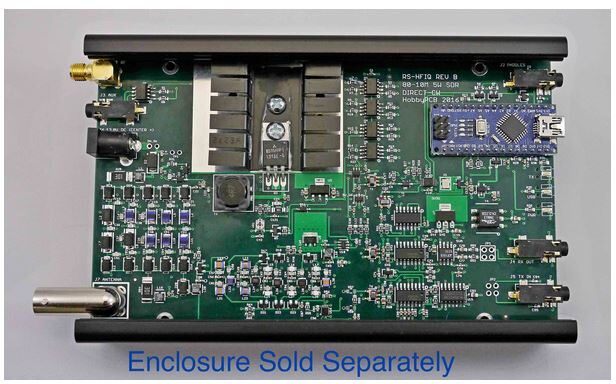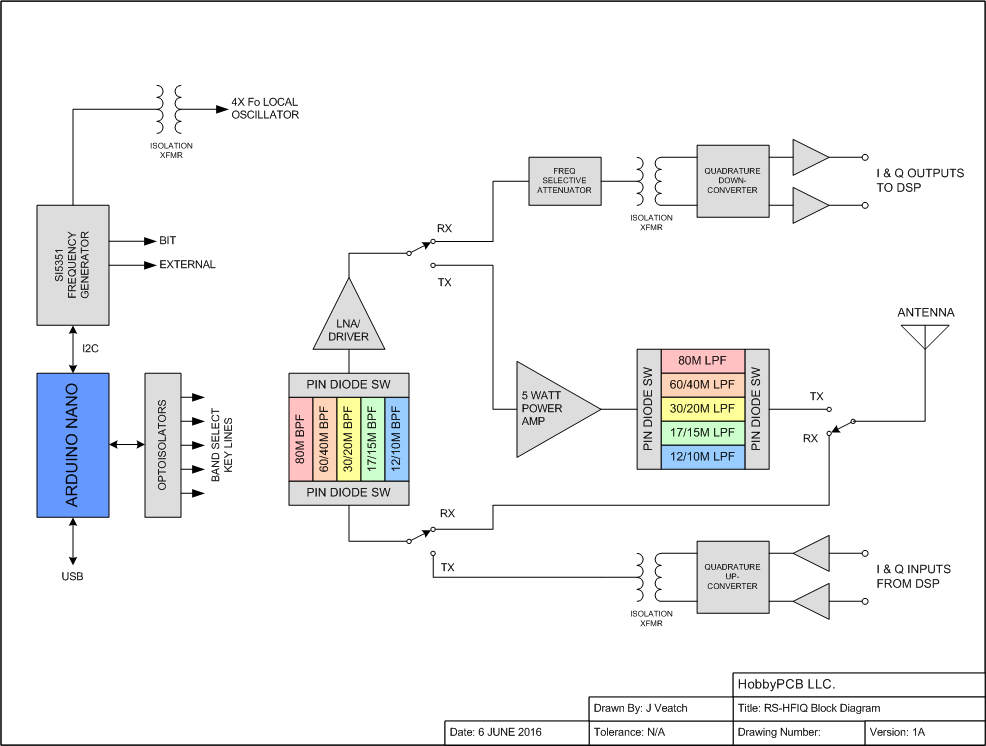The receiver in the RS-HFIQ consists of 5 band-pass filters to reject out-of-band signals, an LNA with frequency dependent gain and a conventional quadrature down-converter.
The transmitter in the RS-HFIQ uses a Quatrature up-converter followed by the same band-pass filters used by the receivers, a 5W power chain and a low-pass filter bank.
The Local Oscillator is based on a Silicon Labs SI5351 chip that can product up to 3 RF outputs, the LO signal for the up/down-converter, a built-in test signal for calibrating I and Q offsets and an external signal.
The control of the SI5351 and all switching functions is provided by an Arduino Nano running open-source software and programmed with the Arduino IDE.
Special care has been taken to insure noise and ground-loop set-up. The RS-HFIQ has three separate DC isolated ground planes; RF/Chassis ground, Baseband/Audio ground and Digital ground. This allows the same PC to be connected to the audio in/out and the USB port on the Arduino Nano without creating noise/grounding issues.
5W not enough power? Add a HARDROCK-50 to your station to boost up to 50W. The RS-HFIQ and HARDROCK-50 seamlessly integrate together for a powerful base station!
Specifications
- Frequency Range – 3-30MHz (performance guaranteed on 80/60/40/30/20/17/15/12/10M ham bands)
- Sensitivity – MDS < -128 dBm on 80M dropping to < -135 on 10M (depending on processing bandwidth and sound card performance)
- TX Power 5W typical, 4W minimum
- LO Feed-thru < -50 dBc @ 5W output
- Spurious and Harmonics < -50 dBc typical
- DC Power 13.8VDC, 2 amp max plus USB power for the Arduino Nano
- Size – 100MM x 160MM
Requirements
The RS-HFIQ is NOT a stand-alone transceiver, it is a part of a Software Defined Radio system. The SDR system consists of:
- Radio front-end – The RS-HFIQ
- Data conversion – Analog to Digital and Digital to Analog typically provided by a high-quality sound card
- Computer hardware – A digital signal processor or high speed general purpose processor.
- SDR Software – to process TX and RX signals
Video by HobbyPCB
While many different configurations are possible and even encouraged, they have developed a ‘standard’ configuration that will help users new to SDR’s go up and running quickly. To get on the air with the RS-HFIQ in the standard configuration you will need:
RS-HFIQ
StarTech – 96 KSPS sound card
Windows PC – running Windows 7, 8 or 10 with speakers and two available USB ports
13.8V 3A power supply
Microphone
Various USB and audio cables
HDSDR and Omni-Rig software
A valid Amateur Radio license is required for transmitting
Antenna system
Visit the RS-HFIQ Transceiver Wiki for more information.
Price: $239.00 USD


